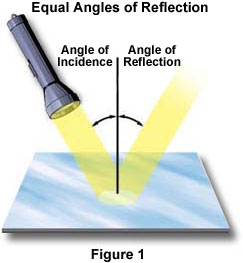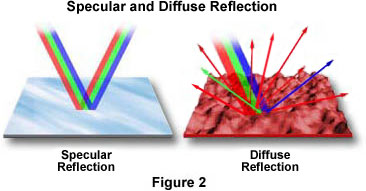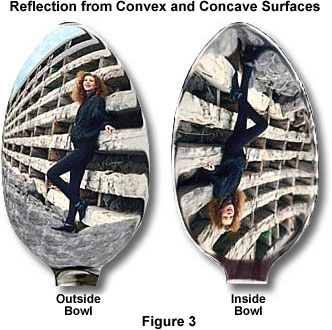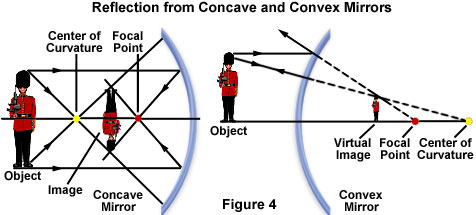Reflection of Light
Reflection of light and other forms of electromagnetic radiation occurs when waves encounter a boundary that does not absorb the radiation's energy, but instead bounces the waves off its surface. In such cases, the incoming light wave is referred to as an incident wave and the wave that is bounced from the surface is called the reflected wave. This simple concept can be easily illustrated by a flashlight and a glass mirror.

In Figure 1, the visible white light emitted by the flashlight bulb is directed onto the surface of a mirror at an angle, described as the angle of incidence. This light is then reflected back into space at another angle, known as the angle of reflection. As shown above, the angle of incidence for visible light is equal to the angle of reflection. This concept, which holds true for all types of electromagnetic radiation, is often termed the law of reflection. It is important to note that the light in Figure 1 is not separated into its component colors because all wavelengths are being reflected equally, rather than being "bent" or refracted.
| Interactive Java Tutorial | |||||||||||
|
|||||||||||
The amount of light reflected by an object is highly dependent upon the texture of its surface. When surface imperfections are smaller than the wavelength of the incident light, as in the case of a mirror, virtually all of the light is reflected. However, in the real world most objects have convoluted surfaces that scatter incident light. Thus, the reflection of light can be roughly categorized into two types. The first, defined as light reflected from a smooth surface at a definite angle, was demonstrated in Figure 1 and is called specular reflection. The second type, which is known as diffuse reflection, is produced by rough surfaces that tend to reflect light in all directions. In a typical environment, there are far more occurrences of diffuse reflection than specular reflection.

The differences between specular and diffuse reflection are illustrated above in Figure 2. On the left, the mirror reflects the red, green, and blue components of white light almost equally and the reflected light is the same angle from the normal as the incident light. On the right side of Figure 2, however, the light that is reflected from the rough surface is scattered in all directions. Also, the rough red surface does not reflect all wavelengths equally because it absorbs most of the blue and green components.
| Interactive Java Tutorial | |||||||||||
|
|||||||||||
Perhaps the best example of a specular reflection is the mirror image that most people use to observe themselves every day. The mirror's smooth reflective glass surface creates a virtual image of the observer from the incident light, which is reflected directly into the observer's eyes. An interesting feature of this reflection is that the image of the object being observed appears to be as far behind the plane of the mirror as the object is in front.
However, mirrors are not always flat and can be produced in a variety of configurations that provide interesting reflection patterns. Concave mirrors, for instance, are commonly used in the largest optical telescopes to collect the faint light emitted from very distant stars. The curved surface of a concave mirror can concentrate parallel rays into a single point for enhanced intensity. This mirror design is also commonly found in shaving mirrors where the reflected light produces a magnified image of the face. Convex mirrors, on the other hand, are often used in automobile right-hand rear-view applications where the outward mirror curvature produces a smaller, more panoramic view of events occurring behind the vehicle. Convex mirrors are also frequently utilized as wide-angle mirrors in hallways and businesses for security and safety. Yet, the most amusing applications for curved mirrors are the novelty mirrors found in state fairs, carnivals, and fun houses. These mirrors often utilize a mixture of concave and convex surfaces to produce bizarre, distorted reflections.

The bowl of a spoon is an excellent example of both a concave and convex mirror surface. In Figure 3, the same image is reflected at the same distance from both the inside and outside bowls of a spoon. The outside bowl, illustrated on the left-hand side, simulates a convex mirror reflecting an image of a woman standing beside a wooden sea wall. The image appears to spread out at the edges of the spoon bowl and seems to be reflected by light rays emitted from a location behind the spoon. Also, the image is smaller than that reflected from the inside bowl illustrated on the right-hand side of Figure 3, and is upright because the reflected light rays do not cross a focal point. The image reflected from the inside bowl of the spoon, however, is inverted because the light waves intersect at the focal point before being imaged.
| Interactive Java Tutorial | |||||||||||
|
|||||||||||
The diagram presented below in Figure 4 illustrates the reflection patterns obtained from both concave and convex mirrors. The concave mirror on the left has a reflecting surface that curves inwards that resembles a portion of the interior of a sphere. When light rays that are parallel to the principal, or optical axis, reflect from the surface of a concave mirror, in this case, the rays leading from the soldier's hat and feet, they converge on the focal point in front of the mirror. The distance from the reflecting surface to the focal point is termed the mirror's focal length. The size of the image depends upon the distance of the object from the mirror and it's position with respect to the mirror's surface. In this case, the soldier is placed at the center of curvature and the reflected image is upside down and in front of the mirror's center of curvature.

The convex mirror on the right-hand side of Figure 4, however, has a reflecting surface that curves outward, which resembles a portion of the exterior of a sphere. Light rays parallel to the optical or principal axis are reflected from the surface in a manner that diverges from a focal point that is behind the mirror. Images formed with convex mirrors are always right side up and reduced in size. These images are also termed virtual images because when they occur reflected rays appear to diverge from a focal point behind the mirror.
| Interactive Java Tutorial | |||||||||||
|
|||||||||||
The reflection of visible light is crucial to the operation of most modern microscopes. Within the instruments, light is reflected along a series of plane or flat mirrors which direct the light path through lenses that form the virtual images that can be seen in the oculars, or eyepieces. Microscopes also make use of beam-splitters to allow some light to be reflected while simultaneously transmitting other light to different parts of the optical system.
Contributing Authors
Mortimer Abramowitz - Olympus America, Inc., Two Corporate Center Drive., Melville, New York, 11747.
Shannon H. Neaves and Michael W. Davidson - National High Magnetic Field Laboratory, 1800 East Paul Dirac Dr., The Florida State University, Tallahassee, Florida, 32310.
